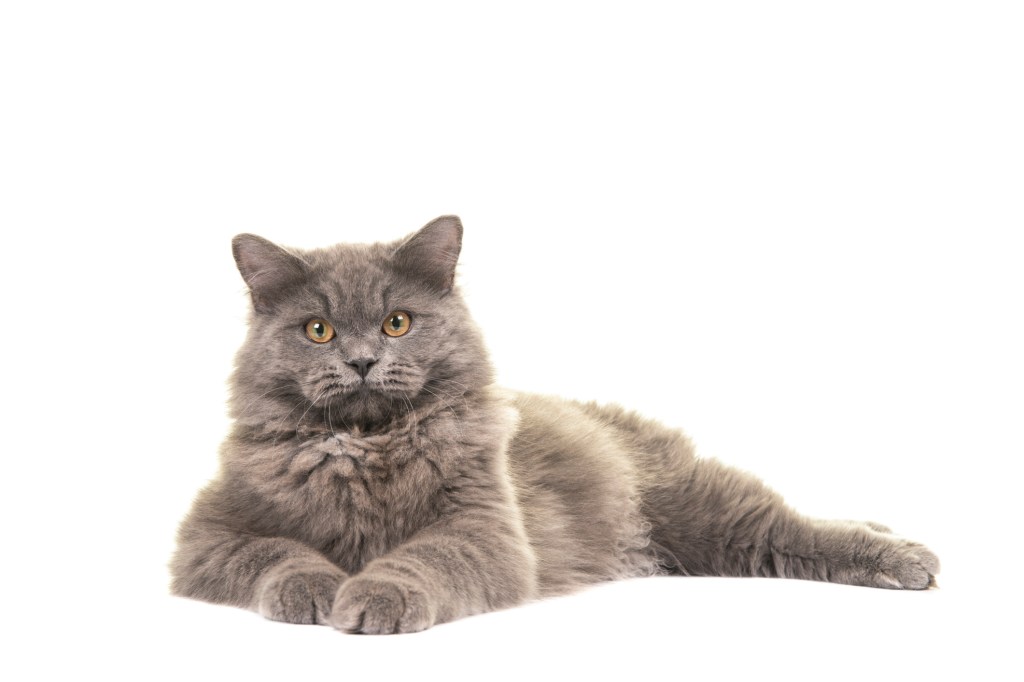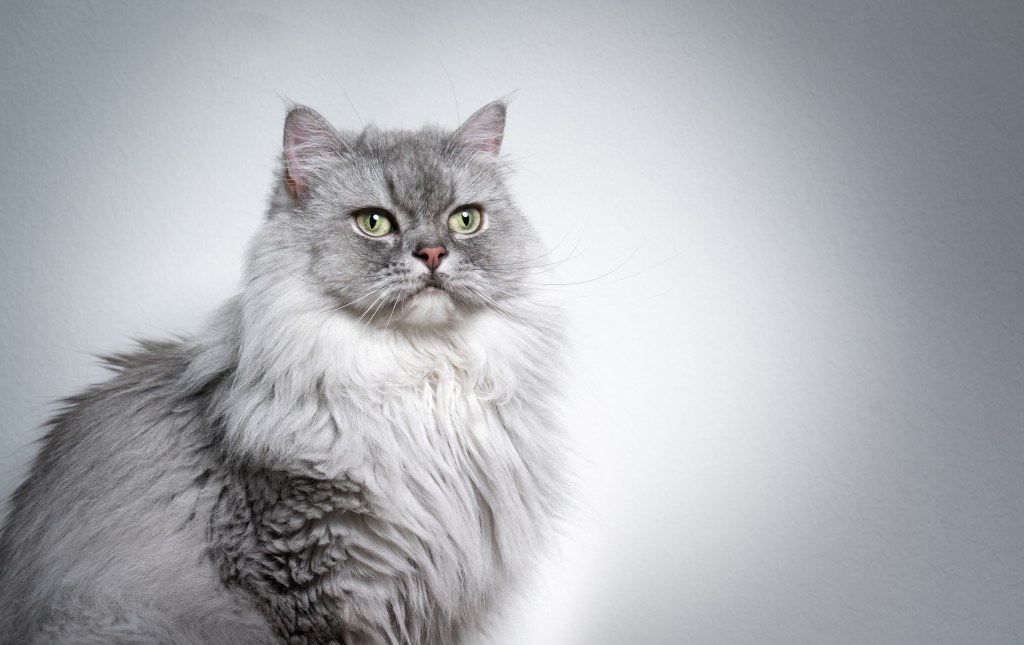The British Longhair is a mixed breed cat–a cross between the British Shorthair and Persian cat breeds. Friendly, independent, and affectionate, these cats inherited some of the best traits from both of their parent breeds.
The British Longhair is an easygoing cat who looks like a plush teddy bear in feline form! These cats enjoy human company, but they’re also independent and low key enough to be okay if left alone for longer periods of the day. Just remember that when you’re dealing with a long-haired feline, there are extra grooming needs to commit to.
When considering a British Longhair, it’s advisable to prioritize adopting from rescue organizations or shelters to provide a loving home to a cat in need. However, if you decide to purchase a British Longhair kitten, it’s crucial to choose a reputable breeder. Conduct thorough research to ensure that the breeder follows ethical practices and prioritizes the well-being of their cats. Reputable British Longhair breeders prioritize the health and temperament of their cats, conduct necessary health screenings, and provide a nurturing environment for the kitties. This active approach ensures that you bring home a healthy and happy kitty while discouraging unethical breeding practices.
Quick Facts
- Origin: United Kingdom
- Size: Medium to large
- Breed Group: Longhair
- Lifespan: 12-16 years
- Coat: Long, dense, with a soft, silky undercoat
- Temperament: Gentle, affectionate, and laid-back
- Exercise Needs: Moderate
- Training: Relatively easy to train
- Grooming: Regular brushing to prevent mats and tangles
- Health: Generally healthy, but can be prone to certain genetic health conditions, such as hypertrophic cardiomyopathy (HCM) and hip dysplasia
- In a fun little cameo, a British Longhair makes an appearance in the 1997 film “Spice World.”
- The most popular color of the British Longhair is blue.
- Only The International Cat Association recognizes the British Longhair as a breed.
British Longhair Pictures





-
Affectionate with Family
Some cat breeds are typically independent and aloof, even if they’ve been raised by the same person since kittenhood; others bond closely to one person and are indifferent to everyone else; and some shower the whole family with affection. Breed isn’t the only factor that goes into affection levels; cats who were raised inside a home with people around feel more comfortable with humans and bond more easily.

See Cats Less Affectionate with Family -
Amount of Shedding
If you’re going to share your home with a cat, you’ll need to deal with some level of cat hair on your clothes and in your house. However, shedding does vary among the breeds. If you’re a neatnik, you’ll need to either pick a low-shedding breed or relax your standards. This furniture cover can make it easier to clean up cat hair and keep it off your sofa!
-
General Health
Due to poor breeding practices, some breeds are prone to certain genetic health problems. This doesn’t mean that every cat of that breed will develop those diseases; it just means that they’re at an increased risk. If you’re looking only for purebred cats or kittens, it’s a good idea to find out which genetic illnesses are common to the breed you’re interested in.
-
Potential for Playfulness
Some cats are perpetual kittens—full of energy and mischief—while others are more serious and sedate. Although a playful kitten sounds endearing, consider how many games of chase the mouse-toy you want to play each day, and whether you have kids or other animals who can stand in as playmates. A classic wand cat toy like this one is perfect for playful felines!
-
Tendency to Vocalize
Some breeds sound off more often than others with meows, yowls, and chattering. When choosing a breed, think about how the cat vocalizes and how often. If constant “conversation” drives you crazy, consider a kitty less likely to chat.
-
Kid-Friendly
Being tolerant of children, sturdy enough to handle the heavy-handed pets and hugs they can dish out, and having a nonchalant attitude toward running, screaming youngsters are all traits that make a kid-friendly cat. Our ratings are generalizations, and they’re not a guarantee of how any breed or individual cat will behave; cats from any breed can be good with children based on their past experiences and personality.
-
Friendly Toward Strangers
Stranger-friendly cats will greet guests with a curious glance or a playful approach; others are shy or indifferent, perhaps even hiding under furniture or skedaddling to another room. However, no matter what the breed, a cat who was exposed to lots of different types, ages, sizes, and shapes of people as a kitten will respond better to strangers as an adult.
-
Easy to Groom
Some breeds require very little in the way of grooming; others require regular brushing to stay clean and healthy. Consider whether you have the time and patience for a cat who needs daily brushing. You should definitely pick up this awesome de-shedding tool for cats of any hair length!
-
Intelligence
Some cat breeds are reputed to be smarter than others. But all cats, if deprived the mental stimulation they need, will make their own busy work. Interactive cat toys are a good way to give a cat a brain workout and keep them out of mischief. This scratcher cat toy can keep your smart kitty busy even when you’re not home!
-
Pet Friendly
Friendliness toward other household animals and friendliness toward humans are two completely different things. Some cats are more likely than others to be accepting of other pets in the home.
British Longhair History
When it comes to the history of the British Longhair, it all begins with the parent breed that gives these cats their names–British Shorthair. At some point widely speculated to be between 1914 and 1918, breeders began to cross the British Shorthairs with the Persians in a bid to produce a kitty with longer hair. The British Longhair was the result, and the breed has prospered as a super popular domestic cat ever since!
In 2009, the British Longhair was officially granted championship status by the International Cat Association (TICA). These days, you may find British Longhairs in shelters or in the care of rescue groups. Consider adoption if you decide this is the breed for you!
British Longhair Size
The British Longhair is a medium- to large-sized cat breed who’s often a little on the stockier side. As is always the case, exact size standards might vary.
Most British Longhairs weigh in at nine to 18 pounds. That said, many may be smaller or larger than average.
British Longhair Personality
At heart, the British Longhair is a loving and friendly cat who will also show a great deal of tolerance. They are sociable towards people when they’re around, but the breed is also happy to enjoy their own time, which makes them a smart choice for someone who might be away from the home for long hours due to work commitments.
While there is a laid-back nature about the British Shorthair, it’s important to encourage the breed to stay active and engage in exercise. Think of the British Longhair as a breed of cat that you’ll need to invest some time and effort in when you’re around them to get the best out of them.
Also note that the British Longhair is an affectionate cat, but they do not generally enjoy being picked up or carried around. They are a breed that might be better suited to adult lifestyles rather than a home buzzing with kids all the time.
British Longhair Health
British Longhairs are generally considered to be healthy cats; although, it’s important to schedule regular wellness visits with your cat’s vet. Some of the more common health problems British Longhairs suffer from include:
- Renal Polycystosis: Renal polycystic disease in cats, also known as feline polycystic kidney disease (PKD), is an inherited condition that leads to the development of multiple fluid-filled cysts in the kidneys. This condition is most commonly seen in Persian and related breeds. PKD is an autosomal dominant genetic disorder, meaning that only one parent needs to carry the gene for their offspring to inherit the disease.
- Neonatal Isoerythrolysis: Neonatal isoerythrolysis (NI) in cats, also known as hemolytic icterus, is a condition that affects kittens. It occurs when there’s an incompatibility between the blood type of the mother cat and her kittens, specifically related to the blood group antigens. This condition is most commonly seen in cats, particularly those of blood type B.
British Longhair Care
The British Longhair needs a little coaxing to make sure they remain active and engage in enough exercise. Otherwise, feline obesity and other related health issues might set in. A smart way to encourage the breed to exercise is through the use of treat-based games and play sessions. Also, consider interactive feeding devices if it seems like your British Longhair is becoming a little too much of a lounge cat.
Along with scheduling yearly wellness vet visits, your British Longhair will need to have their nails checked and trimmed on a regular basis. If you’re new to cat maintenance, your vet can show you the safest way to carry this out. Adding a scratching post to your living environment can also help promote healthy scratching and keep the cat’s nails in good condition.
Beyond nail care, examine the British Longhair’s ears for signs of dirt building up or possible infection every couple of weeks. It’s also smart to speak to your vet about beginning a regular teeth brushing regimen that will suit your British Longhair.
British Longhair Coat Color And Grooming
The British Longhair’s coat can come in a wide range of colors, although blue is the most popular shade. Other frequent colors include tabby, white, cream, and black. As the name suggests, the British Longhair is a long-haired cat whose luxurious coat will require a commitment to daily brushing. This is imperative to help ward off any mats forming, and during times of seasonal shedding, you’ll need to engage in longer than usual brushing sessions.
Regular grooming will also lessen the chances of hairballs occurring. When it comes to climate, the British Longhair is generally seen as an adaptable cat who can usually live happily in most climates. Just remember to always make sure adequate shade and fresh water is provided when the temperature spikes.
Children And Other Pets
The British Longhair can live happily with children. Although, this generally tolerant cat often doesn’t take well to being picked up and carried around. So be sure that early socialization takes place and boundaries are properly set on both sides, and supervise early interactions between kids and cats.
When it comes to other household pets, the British Longhair is usually fine sharing living quarters. However, you’ll want to supervise early interactions between the new cat and existing pets, as well. Ultimately, early socialization really pays off with this breed. Make sure to reward your British Longhair for good behavior when you bring them home to your family!
British Longhair Rescue Groups
It may be hard to find a breed specific rescue for British Longhair cats because they are a mixed breed. However, you may want to try British Shorthair or Persian cat breed specific rescues, as they sometimes care for breed mixes. You may also try shelters and rescues that cater to all types of cats, including British Longhair cats, as well as your local shelter. Here are some nonprofit rescues you can try:
More Info For You
If you’re also looking for a dog, check out DogTime’s dog breed page!





